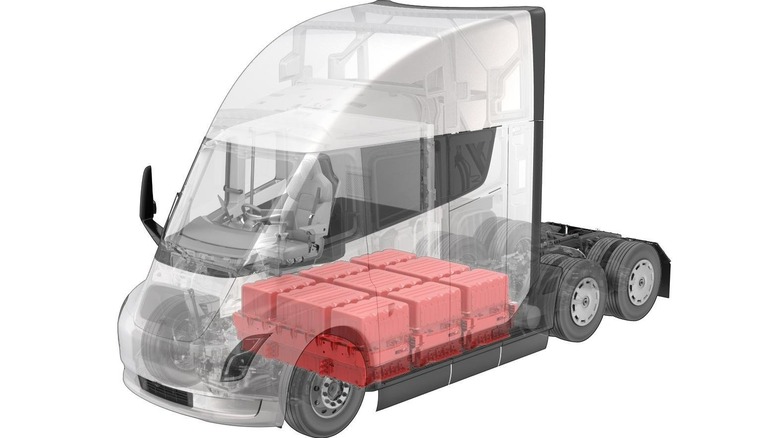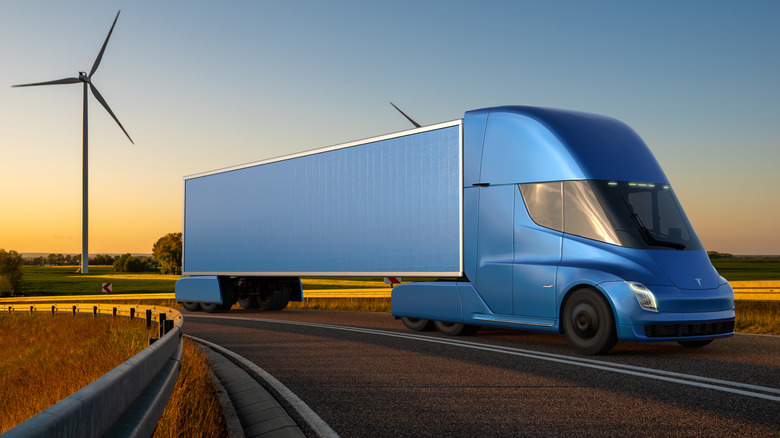This Design Leak Revealed What Makes The Tesla Semi So Special
A recent design leak has given the consumer marketplace a brand-new look into the features that underpin the Tesla Semi. Green the Only, a well-known Twitter profile associated with a hacker focused on acquiring and releasing Tesla information, provided crucial insight into the design and mechanics of the Tesla Semi's battery pack.
The Semi was first unveiled in 2017, even as Elon Musk tried to keep the design and specifications of the vehicle a mystery (via Electrek). Electrek also notes that analysts estimated an operational cost reduction of as much as 70% to run this electric semi versus the standard diesel-powered model that dominates highway trucking today. These features make the EV an exciting new entry into the automotive world, but with new reporting from Green the Only, those interested in how the truck delivers on these lofty goals can whet their appetite for the nitty gritty details end game greater insight into how Tesla aims to deliver on the promises of industry disruption with this exciting newcomer.
The battery packs a massive capacity and acts as a foundation for the low center of gravity
The nuanced revelations provided by leaks from Green the Only offer an in-depth look at the battery layout and other mechanical features of the Tesla Semi. The truck packs a 900 kWh battery array that puts the average consumer EV's capacity to shame. Eon Energy reports that a typical EV will offer around 40 kWh capacity, with the highest capacity batteries reaching as much as 100 kWh ratings. Creating a battery pack that offers nearly 10 times more charge capacity than the biggest existing batteries on the market gives the Tesla Semi the power it requires to deliver extensive driving range and optimal power for hauling the heavy loads that semis are required to tow on a daily basis.
The volume offered by the Tesla Semi isn't the only unique feature of the battery array, however. Electrek notes that the batteries are much larger than those found in other Tesla vehicles and the design specifications that have been leaked show them mounted low to the ground and directly beneath the truck's cabin. This places the heaviest component of a standard EV in a fantastic position to affect the vehicle's center of gravity. Motor and Wheels notes that a Kia Soul's 64 kWh battery weighs 1,000 pounds, and the Ford F-150 Lightning's massive 131 kWh battery comes in at about 1,800 pounds. Bringing the total charge capacity up to such an extreme will add substantial poundage to the low front of the vehicle's overall volume, creating what might potentially be a much safer semi to drive on long-haul journeys across the country.
We're still waiting on details surrounding the total weight of the vehicle
One specification that hasn't yet been made public through press releases or leaks is the total weight of the Tesla Semi. Green the Only offers wide-ranging details on the battery layout for the truck but hasn't yet shared information on the truck's own weight (without a load). The Tesla Semi's gross vehicle weight rating is roughly in line with other trucks of this class though, according to the data provided.
The Detroit News reports that electric vehicles weigh more than their internal combustion engine equivalents, and this poses unique challenges in the form of road maintenance for everyday drivers. But for the trucking industry, vehicle weight adds another wrinkle to the calculation of profitability and efficient hauling of all types of goods across the country. With restrictions on how much a truck can haul, there is a careful balancing act that goes into the design of a semi to create the best power output possible (in order to haul more weight effectively) while keeping the truck's curb weight at a minimum. This allows for an increase in the profit margin that a trucker and his or her company can achieve with each voyage. The more a truck can carry, the more a driver can expect to make on a routine journey from one destination to the next. If the Tesla Semi weighs substantially more than its compatriots on the highway, then drivers who opt to switch over to this fully electric model may do so at the risk of notably reduced earnings.
Tesla's fully electric Semi could make a monumental change within the industry
While the production of Class 8 trucks in the form of the Tesla Semi might not seem like something that directly affects the average consumer, the truth is that this fully electric semi has the potential to effect enormous and lasting change within the trucking industry and across total global emissions as well. Electrek reports that even though only 1% of vehicles on U.S. roads are trucks of this size hauling goods from one place to another, this class of vehicle accounts for 20% of all U.S. vehicle emissions and 36% of all U.S. vehicle particulate emissions. These numbers are staggering, and a change here can make for a vastly different global outlook when it comes to battling climate change and improving the environment for the better.
If the Tesla Semi is able to make a splash even half the size that the brand predates for its new vehicle then we may be looking at a sea change in the way that goods are moved overland. In coordination with efforts to cut the emissions of seafaring vessels, there is hope for a future in the transportation sector that provides consumers with the goods they need and are accustomed to without devastating the environment that we rely on as our home.



